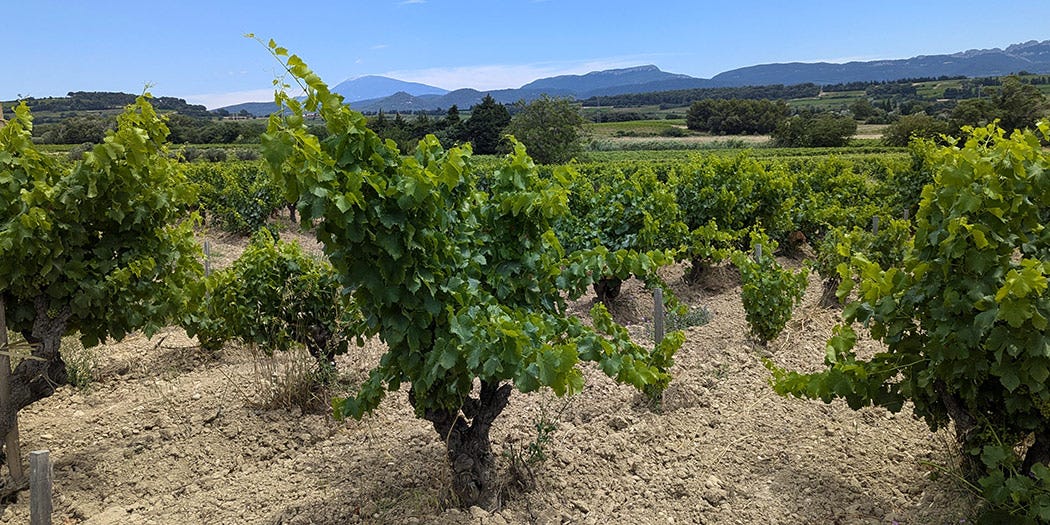That fine Cairanne & the Ides of August
Year 14, No. 15
Highlights: Cairanne Regional Report | Clos Erasmus Preview
In Catalunya’s Priorat region, traffic has been somewhat problematic as of late.
It’s definitely not a Los Angeles style problem in having too many cars on the road—there are after all only 9,000 people in the whole county. It’s also not due to some massive influx of tourists as the beach is world away, about 18km over some very non-beachy hills.
The actual reason for this uptick in rural traffic is in fact very telling of the current issues facing viticulture in that there’s an excess of tractors everywhere, with massive cistern trailers attached to them.
Most anywhere you drive on the twisty roads of the county, you’ll suddenly hit a slow down and be trundling behind a tractor dragging a 10,000l cistern full of water at 20kph to various destinations. But, as there is no water in the region, this is all being dragged up, into these hills from other areas, such as the Ebre River, or other wineries outside of Priorat that somehow have extra water this year.
Most of this is, in theory on the level, with proper documentation and great amounts of money being paid to keep the vines alive that haven’t already died. If you’ve ever wondered why Priorat wines are more expensive than others in Spain, it’s things like this that make the cost of winemaking get higher every year.
Some of this water movement is however not actually legal as shifting water between basins is prohibited and the police have stepped up patrols. One would assume they’ve more manpower now that ex-president Carles Puigdemont managed to slip in and out of the country despite a seven year-old warrant against him.
The irony of this enforcement is thick however, given that the main river through Priorat (the Siruana) is almost completely diverted out to a resevoir on the coast, thus aggravating the situation futher. The diversion was originally done a century ago in the name of agriculture, but it’s being massively abused now, supplying beach hotels, various municipalities, and even the city of Reus.
This has left a situation in Priorat that’s not actually new, but has got ever more dire as it’s not just wineries that need water. Hotels use a great deal of water as well and I’ve heard rumors that one which drilled a well when they were doing construction, doesn’t have water and they’re also trucking it in. And let’s not forget that one village has been having drinking water delivered for over a year now as what meager tap water they have, isn’t fit for consumption.
Whatever the case, for anyone with a cistern they can snap on to the back of a tractor, it’s go time. We’re just before the main part of the harvest, the days are the hottest they’ve been all year, and there’s zero rain in sight. But, seemingly around the clock, there are these tractors churning through diesel (adding to Climate Change along the way) to move water around in what is a terrifying, but unfortunately realistic view of the future.
To rub salt in the proverbial wounds, where I’ve been in Southern France during the first half of this year, they’re having the opposite problem. In nearly every region north of the Pyrénées, there has in fact been too much precipitation and viticulturists are now dealing with fungal issues setting in just before harvest.
It was on the minds of producers in Cairanne when I was there at the start of July to compile this exciting new Regional Report that tastes nearly 100 wines. The Cairanne folk have thankfully been helped by the mighty mistral wind of the Rhône region to keep things relatively dry, but even a month ago there were the tell-tale signs of mildew setting up shop. It’s clear that no matter where you are in Europe, 2024 is making for a lot of work in the wine world.
On the topic of ongoing work, Rioja has just released another batch of their single vineyard wines or Viñedos Singulares (*) which shows that there continues to be interest in the certification. It’s been continually growing since introduced in 2017 and is allowing for a different aspect to shine in this most-namechecked region of Spain.
Also new is the exciting release of a white wine from Clos Erasmus, a winery that had otherwise been known for only making reds in its 35 years of existence. This article provides an exciting taste of that white, their delicious 2022 reds, and a preview of wines in the Priorat report that’s arriving very soon.
Drink well, be well.
-Miquel
(*) Free to read
The Featured Report
Cairanne Report 2024
While this, the newest of ‘crus’ in Southern Rhône is tucked amongst what are perhaps more famous appellations, Cairanne has been softly crafting some fine reds and whites for a long time and here we take a proper look at these.
And now this
In something of a bonus report, we take a look at the very choice 2020 wines from the Grandes Maisons association up in Burgundy which were tasted during an excellent showcase and meal via the Grands Jours de Bourgogne this past March.
Sadly, if you haven’t had rain in a region, then the risk of fire is extremely high, as shown by a local wildfire that burned through a prized vineyard (*) in the Priorat region.
While it’s easy to paint all Russians as being the bad guys in their invasion of Ukraine 2.5 years ago, there are those who have been trying to fight the regime in Moscow. For his troubles, drinks magnate, Yuri Shelfer has found himself in the position of being stuck between Russia and Brad Pitt (*) of all things as Sergey Panov reports.



